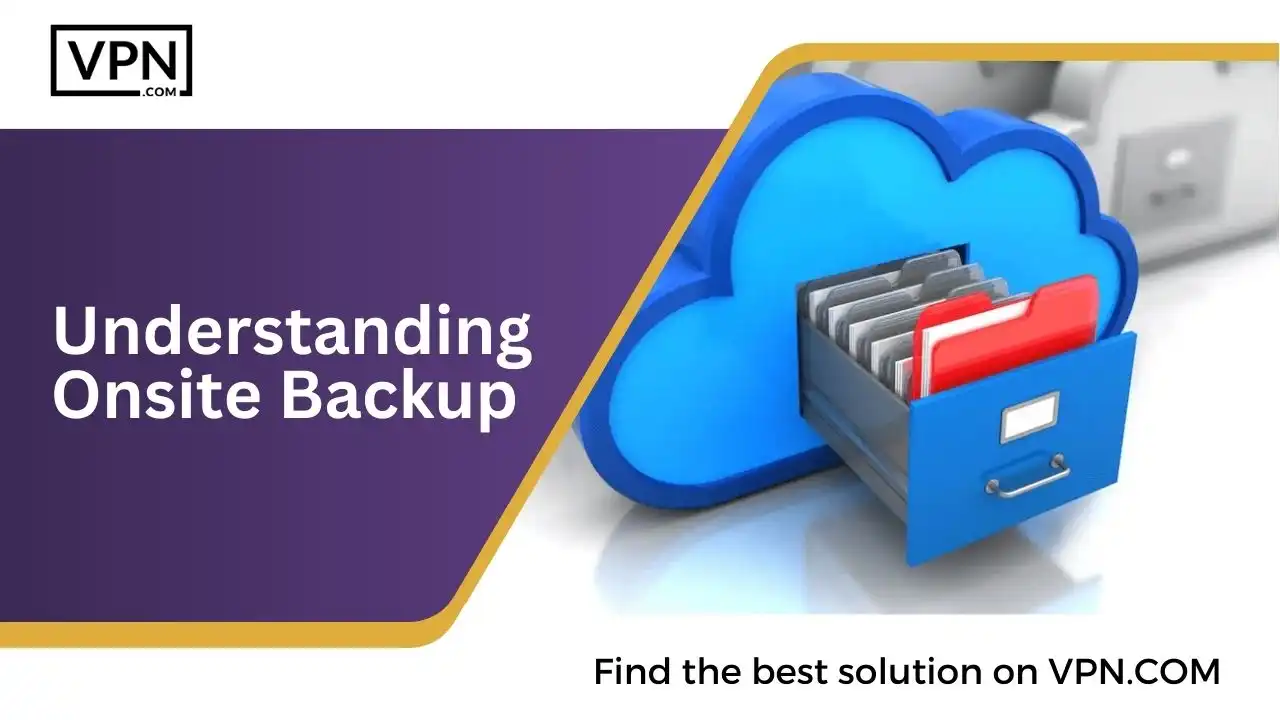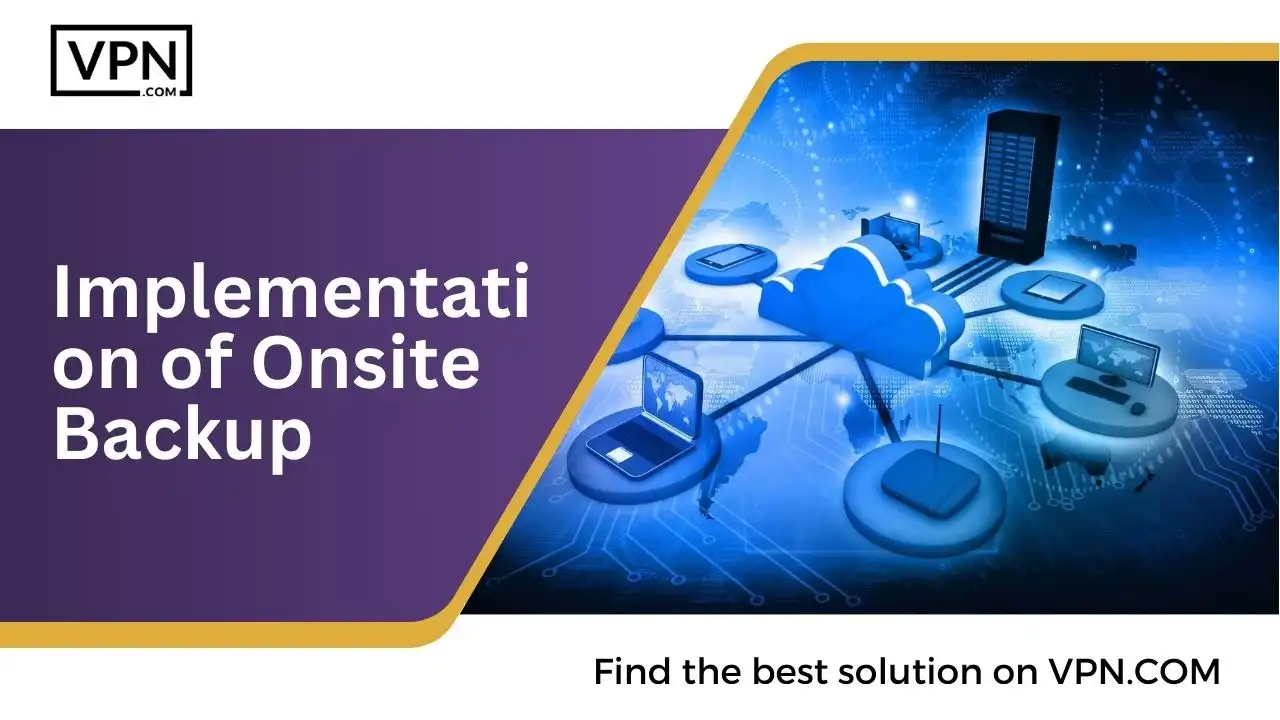Secure Your Data With Best Onsite Backup Providers

Nowadays, safeguarding firm data is of the utmost importance. Severe delays, significant financial losses, and damage to brand reputation can result from data loss. Rest assured! Such a disaster can be averted with a reliable Onsite Backup Provider’s plan.
“Onsite backup” refers to storing duplicate data on office-based devices, managed by an Onsite Backup Provider. If anything goes wrong, this makes file restoration incredibly fast. And compared to other backup options, it’s pretty budget-friendly! However, you must ensure you have the correct system and Onsite Backup Provider.
Therefore, let’s discuss the most effective methods for backups with an Onsite Backup Provider! Important pointers like regular testing, off-site copy storage, and the appropriateness (or lack thereof) of cloud solutions will be covered. In addition, we will go over the most essential details to remember when choosing Onsite Backup Providers, including things like recovery times, prices, and security-related inquiries.
So, what’s the verdict? A plan for offsite data backup should be in place at all times with an Onsite Backup Provider. It is your data, not mine. Here, you will find detailed instructions from an Onsite Backup Provider on how to stay protected, cut costs, and be confident in your ability to withstand cyberattacks or the wrath of Mother Nature. So that your business continues to thrive, read on!
Understanding Onsite Backup

“Onsite backup” means keeping backup copies of data on storage media already present at the company’s physical location, like servers, hard disks, or DVDs. Most people like this data backup option since it’s easy to use, doesn’t cost a lot, and recovers data quickly.
Nevertheless, there are downsides to it. Potential causes of data loss in onsite backup systems include human mistakes, theft, vandalism, and natural disasters.
Furthermore, scalability issues may arise due to acquiring more hardware as data volumes increase. Onsite backup is still an essential component of a data protection plan, even with all these problems. It protects data from loss and allows for fast recovery during an interruption.

Signup at our #1 host
- Reduce Costs
- Shorten time to market
- Increase efficiency
- Improve agility & consistency
GUARANTEE
Advantages of onsite backup
Robust data protection methods should include onsite backup solutions because of their many benefits. Because data may be transferred quickly when the storage medium is close to the source data, the speed of backup and recovery processes is the most noticeable advantage. For companies that can’t afford any downtime, this can be critical.
In addition, compared to cloud storage options, which incur ongoing fees, onsite backup often requires a one-time investment in storage gear, making it more cost-effective in the long term.
Another perk is the system’s scalability; when a business’s data needs increase, it can add more storage to the current setup. Because of this adaptability, companies may design backup systems that meet their unique requirements, avoiding wasted money by always having enough storage.
Disadvantages of onsite backup
Onsite backup systems have their benefits but have drawbacks. The potential for human mistakes is one of the main drawbacks. Two examples are forgetting to back up data regularly or inadvertently overwriting crucial files. Also, theft and vandalism are risks to backup systems located on-site. These threats could cause substantial data loss as the backup data is kept on the company premises.
In addition, calamities might still affect onsite backup solutions. The actual storage devices can be destroyed in disasters like fires or floods, and the backed-up data can be lost forever. In light of these difficulties, it is critical to establish thorough data protection plans, which might incorporate a mix of onsite and offsite backup options.
Best Practices for Onsite Backup

A complete data protection strategy must include onsite backup. It serves as a first line of protection to prevent data loss and enable rapid recovery after interruptions. However, certain best practices must be followed for onsite backup to work efficiently.
The following are examples of best practices: intelligent use of cloud backup, increasing backup frequency, following the 3-2-1 backup rule, and linking backup strategy with service-level expectations. We will go deeply into these best practices, illuminating how to implement them to protect your data.
Increase backup frequency
Best practices for onsite backup should prioritize increasing backup frequency. This is because the frequency of backups determines the likelihood of data loss in the case of an interruption. Backups performed only once per night are insufficient to protect against modern threats such as ransomware. It is recommended to do data set protection numerous times daily.
Because only the modified block, not the entire file, is duplicated to backup storage, technologies like block-level incremental (BLI) backups provide fast backups of nearly any data set in minutes. Data importance and service level requirements should govern the backup frequency.
For instance, it is mandatory to conduct backups at least every fifteen minutes if the service level is fifteen minutes. The data type, dataset size, and business requirements influence how often backups should be performed.
Align backup strategy to service-level demands
A critical best practice for onsite backup is to match your backup strategy with service-level expectations. Adjusting the backup schedule and recovery options to fit the demands of your company’s operations is an integral part of this process.
If your service-level agreement (SLA) stipulates a 30-minute recovery time objective (RTO), your backup plan should be tailored to fulfill this requirement. Methods that facilitate speedy data restoration, such as block-level incremental (BLI) backups and rapid recovery, may be employed.
It’s important to remember that the backup strategy’s alignment with service-level demands can differ based on the severity of the data and applications, as well as the unique operational needs of the company. As a result, developing a reliable backup plan requires an in-depth familiarity with your company’s requirements and service-level expectations.
Follow the 3-2-1 backup rule
Regarding protecting sensitive information, the 3-2-1 backup rule is considered the gold standard. Following this guideline, you should ensure that your data is backed up on two separate types of storage media and that one copy is preserved offsite. This rule is in place to ensure your data is not vulnerable to any one thing going wrong.
Data loss owing to software or hardware failure can be mitigated by having numerous copies on various media types. The offshore copy adds an extra safeguard if the onsite copies are vulnerable to physical threats like theft, vandalism, or natural disasters. Your onsite backup strategy will be far more reliable and robust if you follow the 3-2-1 rule.
Use cloud backup intelligently

It might be prudent for a business to incorporate cloud computing into its backup strategy. Teams can scale up their cloud storage as their data needs increase without investing in expensive new hardware. It shouldn’t serve as the sole backup plan.
Pick and choose what information to upload to the cloud. Staff can save time by automating uploads. Also, be aware that additional costs are usually associated with downloading or transferring data from the cloud to the servers at your workplace.
Coupling cloud backup with routine in-house backups is an intelligent move. Flexibility, improved coverage in the event of an onsite incident, and possible cost savings are all benefits of their combined efforts.
When comparing service providers, consider more than just storage space and cost. Look for a trustworthy cloud provider that can work with your existing tools. Inquire about the speed with which backup data can be accessed during a disaster. How intuitive are their control panels and backup options?
It is essential to have a complete image to get the most out of the cloud without encountering any problems. It takes strategy and care to keep firm data safe. You may strengthen your backup framework with the correct partner by blending cloud and local plans. However, prioritize your homework!
Automate disaster recovery runbooks
An essential procedure for on-premises backup is the automation of disaster recovery strategies provided by the Onsite Backup Provider. In an emergency, it is necessary to have a comprehensive plan that outlines what to do, and a disaster recovery runbook provided by an Onsite Backup Provider offers just that. By removing the room for human mistakes, automating these runbooks can drastically cut down on recovery time.
With the runbook automation features offered by some backup systems, businesses can schedule recovery processes to run at specific intervals according to a predetermined order.
Organizations that use multi-tier applications and rely on interdependent servers may find this especially useful, as the success or failure of their operations hinges on the precise sequence in which servers are available and when they are restored. In the case of a disaster, firms can speedily resume operations with minimal disturbance by automating disaster recovery runbooks, which improves the recovery process.
Avoid using backup for long-term data retention
Although backups are crucial for data preservation, using them for long-term data retention is not advisable. The purpose of a backup is data recovery in the near term, not data archiving in the distant future.
Organizations must keep and separate certain data kinds and, in some instances, remove specified components of client data to comply with regulations like GDPR. Because it is difficult to remove data from a backup, it is recommended only to keep data that is needed temporarily in the backup.
Storage bloat and sluggish recovery times are additional consequences of keeping backups for an extended period. Data that must be kept for long periods should be archived in a dedicated system. That backups continue to serve their principal function—the rapid restoration of up-to-date data—is guaranteed by this method.
Choosing the Right Onsite Backup Provider

There are several things to think about when selecting an onsite backup provider:
- A trustworthy supplier should provide continuous performance, high uptime, and little downtime to minimize the risk of data loss; reliability is of the utmost importance.
- Price also has a significant role. The quantity of data to be backed up, the frequency of backups, and the need for additional features or customized plans all affect the pricing of backup services.
- Businesses that are seeing a surge in their data needs must prioritize scalability. The ideal backup solution will work with your existing network and scale to meet your data needs as they expand.
- Businesses prioritize security. Data that is considered sensitive should be protected by robust security procedures. Encryption techniques and multi-factor authentication may make your backups more secure.
- Take the provider’s customer service into account lastly. Contact the provider’s customer service department for assistance if you have any questions or concerns.
Lastly, while looking for an onsite backup provider, ensure they have a good mix of dependability, affordability, scalability, security, and support. To ensure a provider can handle your unique backup requirements, evaluating them using these standards is essential.
Review of top onsite backup providers
There are several excellent options for on-premises backup solutions; some of the most popular ones include IDrive, Backblaze, and Acronis Cyber Protect Home Office.
IDrive’s many features, safety measures, and helpful customer service team have earned it high marks. Various plans are available, catering to both personal and business needs. Since all the plans include cloud storage, IDrive can serve as a backup solution and a cloud storage service.
Users with many devices will find IDrive a versatile solution due to its support for an unlimited number of devices. On the other hand, consumers with a lot of data may find it limited because it provides limited plans. Many users have raved about IDrive, praising its dependability and how easy it is to restore files.
Backblaze is well-known in the industry as simple, user-friendly, and reasonably priced. Users with vast volumes of data will love it because it offers unlimited storage for a low fee. A potential downside for consumers seeking greater control over their backups is the need for additional functionality and customization possibilities. Regardless, consumers rave about Backblaze’s ease of use and effectiveness, contributing to its strong reputation.
Acronis Cyber Protect Home Office stands out with its versatile backup choices and practical security extras. This solution is versatile because it can back up various devices, including mobile devices, network storage drives, and tethered external drives. The backup retrieval process could be sluggish for some users, though. Regardless, Acronis earns rave reviews for being dependable and effective in various situations.
Finally, you’ll want to consider your unique requirements while choosing among the three companies’ onsite solid backup solutions. IDrive’s extensive feature set and flexible pricing make it an excellent all-arounder. Backblaze is the way to go if you value ease of use and limitless capacity. Acronis Cyber Protect Home Office offers backup solutions and other security measures. Before settling on a provider, comparing their offerings to your unique backup requirements is wise.
Implementation of Onsite Backup

To ensure the security of a company’s data, it is crucial to establish an onsite backup solution with an Onsite Backup Provider. This entails making frequent copies of data and keeping it locally, such as on an office server or external hard drive, managed by the Onsite Backup Provider.
Thorough planning is required to set up an onsite backup with an Onsite Backup Provider. You should consider how frequently backups should occur, how long backup data should be kept, and what security measures to implement. An integral part of any data protection strategy, it is the first line of defense in case of a data breach or system outage.
Having backups on-site, managed by an Onsite Backup Provider, allows for faster recovery times in the event of issues. And keep in mind! Data stored at the workplace may still be vulnerable in a disaster, such as a fire or a cyberattack. Keeping a few backups offshore is a good idea.
It requires some work to properly set up the onsite backup with an Onsite Backup Provider. However, implementing robust systems upfront is a crucial insurance policy for catastrophe scenarios. Consider the details carefully, test frequently, and collaborate with IT experts if you require assistance. Ensuring the security of firm data ought to be an essential concern. To achieve this goal, onsite backup with an Onsite Backup Provider is necessary.
Steps to deploy an effective onsite backup strategy
Here are the steps to implement a reliable onsite backup strategy:
- Assess Data Criticality: Find Out Which Data Is Critical For Continuous Operations And How Fast It Must Be Available After A Loss.
- Define Backup Frequency: Consider data importance and regulatory requirements when deciding how often to back up.
- Select Backup Options: You can store your backups in the cloud or on-premises, and you can choose between complete, differential, and incremental backups.
- Set up backup plans: Before implementing the selected backup solution, ensure it meets all of your organization’s requirements, particularly usability and scalability.
- Evaluate and Repair Procedures: Make sure your data can be restored during a disaster by testing your backups regularly.
This approach guarantees the safety and speedy restoration of essential data, reducing the likelihood of downtime and data loss.
Test and monitor your backup system
You must test and monitor your backup system if you want your onsite backup strategy to work. If you want to be sure your backups are adequate and that data can be recovered rapidly, you should test them often. Data integrity and usability testing, problem identification, and backup emulation are all part of this process. Keeping an eye on your backup system lets you catch mistakes or problems as they happen so you can fix them faster.
Backup status, success rates, and possible problems can all be found in comprehensive reports that automated programs can provide. These reports can also produce alarms in the case of a backup failing. By checking in on your backup system regularly, you can see how well it’s working and be sure that your important information will be there when you need it, complete and undamaged.
Keep physical backups off-site for added protection
An extra layer of security for your data can be achieved by storing physical backups in a different location. Protect your principal company site’s backup copies from catastrophic occurrences like fires, natural catastrophes, or system failures by keeping backup copies in a different place.
It is more difficult for harmful operations, such as cyberattacks, to render your company defenseless when you have off-site backups as a redundancy. This approach provides flexibility and security as part of a larger disaster recovery plan by enabling data recovery from a distant location. This ensures that business may continue even if the original site is compromised or inaccessible.
Challenges and Solutions

Problems with onsite backups, including those managed by Onsite Backup Providers, include insufficient testing, long recovery times, and susceptibility to dangers like hacking or fires. There are 14 security concerns on a typical backup device, with three being high-level.
Regular upgrades, safe storage, and support from Onsite Backup Providers are crucial to enhance onsite backup. Better data protection is achieved by backing up more regularly. Also, it helps to adapt the backup plan to the company’s specific demands.
Importantly, keep a copy of your backups in a safe place, away from the leading network. The best way to detect problems early is to test and monitor backups regularly. By utilizing professional assistance from Onsite Backup Providers, typical difficulties can be managed and reduced.
Modern technologies, such as Continuous Data Protection, can solve the problems associated with conventional backup methods by blocking unauthorized backup changes and allowing for thorough recovery in an emergency. Enhanced security, scalability, and flexibility are the benefits of cloud backup.
In conclusion, there are ways to improve onsite backup plans, even when they encounter challenges. Companies can enhance data security through onsite backup by testing and upgrading systems, utilizing secure offsite storage, receiving support services from Onsite Backup Providers, and utilizing newer technologies such as Continuous Data security and the cloud.

Signup at our #1 host
- Reduce Costs
- Shorten time to market
- Increase efficiency
- Improve agility & consistency
GUARANTEE
Conclusion
Compared to alternative options, backup systems offered by Onsite Backup Providers offer faster data recovery and better protection against loss at a cheaper cost. Still, there’s a chance of damage, theft, or human mistake. Onsite Backup Providers must back up data regularly and incorporate cloud backup as part of best practices.
Reliability, affordability, scalability, and security are the primary considerations when picking an Onsite Backup Provider service. Acronis, IDrive, and Backblaze are just a few leading suppliers that provide robust, tailored solutions.
Thorough preparation, testing, and monitoring are necessary to implement an onsite approach successfully. Despite specific difficulties, onsite backup can improve data security and company continuity.
Data protection is of the utmost importance in the modern society. Onsite backup is complex, but enterprises can use it effectively with the help of an experienced Onsite Backup Provider and a deliberate approach to ensure that data is secure, accessible, and protected. Though there are hurdles, the journey towards solid data protection is crucial. This path becomes more realistic for many firms with onsite solutions.
Customer Reviews for Performive.com

Gary Simat Great Leader, Performive Great Company
October, 17 2022

Best Hosting Provider
March, 25 2021

Excellent performance from an elite company.
March, 8 2021




